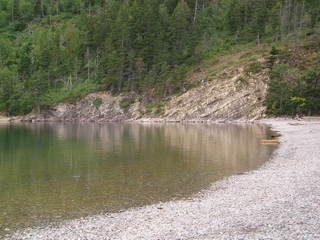|
Spawning Season for the Largemouth BassIf you are not sure what stage of the spawn the Largemouth Bass is in, you need to eliminate water while you determine where the fish are at. There are 4 main criteria that I use to figure this puzzle out. The type of water you are fishing, lake, river, pond, reservoir or stream. Each type warms to spawning temperature differently. You also need to pay attention to what the water is doing. Is it rising, is it draining, does it have current or maybe the temperature is changing. Also, take in to account what time of the year it is, early spring is different then early summer. And finally, watch the weather. Have there been several days of consistent temperatures and patterns or has it been one front after another moving through the area. All of these things help to determine where the fish is in its spawning cycle. There are 4 main time periods during the spawn that are important to know. If you take stock of the 4 criteria mentioned above and determine what stage the fish is in, you can have very successful days no matter where the fish are at. Pre Pre-SpawnThe first main time period for the Largemouth Bass is what I call the Pre Pre-Spawn. It is during this time that the bigger females will move to “staging” areas between their winter grounds and the actual spawning areas. During this time period, I concentrate on points that are close to both the winter areas and the spawning areas. The water temperature will be in the 45-52 degree range and the afternoon air temperatures will begin to warm the shallow waters. My favorite bait during this time period is a Crawdad colored crank bait and I concentrate in depths of 7 feet to 10 feet of water. These transition areas can be very productive this time of year. Pre-SpawnThe next important time period for the Largemouth Bass is the Pre-Spawn. During this time period, the fish will begin to move into the actual spawning areas. The fish will begin to scatter a bit and the smaller males will begin to build the nests. The water temperatures will begin to warm to 52-54 degrees. During this time period, the fish will be very object orientated and move toward the shallow side of any cover they can find in these spawning areas. When you see the males working on the nests, I like to pull off the area into 4-7 feet of water and look for the scattered females. This is where you can target the bigger fish. These fish will still be feeding and I like to move a bit faster since the fish are scattered. SpawnThe next important time period for the Largemouth Bass is the actual spawn. The water temperature will now be 58 degrees or higher and this is when the bigger females will move into the freshly built beds. This stage can last anywhere from 1 or 2 days to 1 to 2 weeks depending on the water and the area you are in. The spawn seems to last longer in the southern United States then it does in the northern states. When you are trying to target the females that are on the bed, I like to use big worms or creature baits like crawfish and lizards. These types of lures will trigger more of a reaction bite then smaller baits that may just be pushed out of the nest by these female fish.
Post-SpawnThe last stage of the Largemouth Bass Spawn is the Post-Spawn period. You may still see the smaller males guarding the nests, but the females have moved off. Some people assume that the females move directly to their summer schooling areas but this is not the case. These females prefer to suspend on some type of object like a brush pile or a rock pile or maybe one big boulder. I start my search at this stage of the spawn in the same areas that I found the females during the pre-spawn. These same areas will be used before they move to the summer areas in 4-7 feet of water; they may also move to the summer areas but will suspend rather then use the bottom. Once again, a searching type bait is the best solution in this time period. If I am still not locating the fish, I will revert back to the pre pre-spawn points and look there. This is the most unpredictable time of the year but once you find the fish, they are usually good ones. So, when you hit the water this spring, determine what stage of the spawn the fish are in and you will be well on your way to having a successful day on the water!!!! By paying attention to the water and your surroundings, you can quickly find the fish and have a leg up on the guys who are still searching.
|

